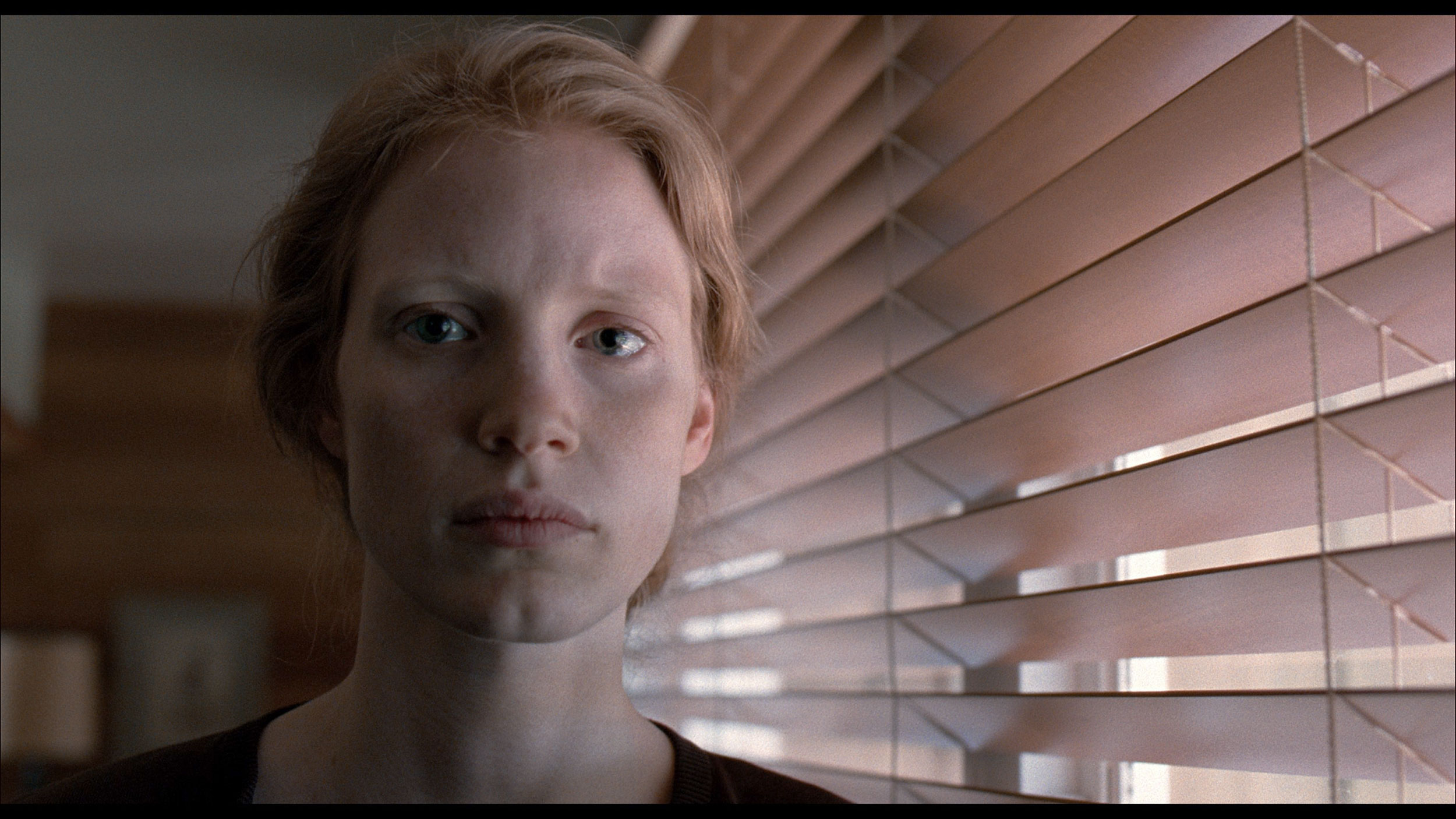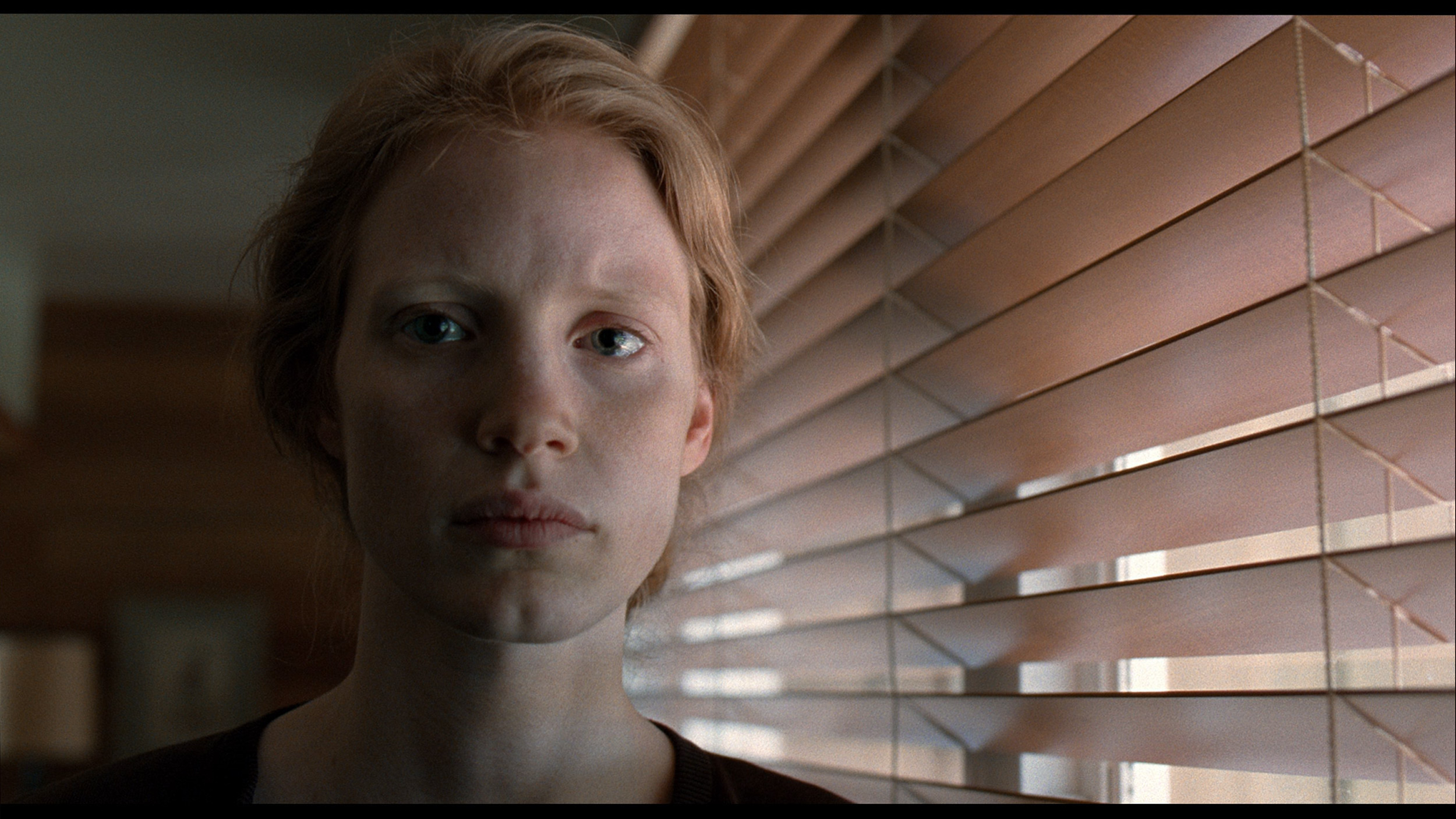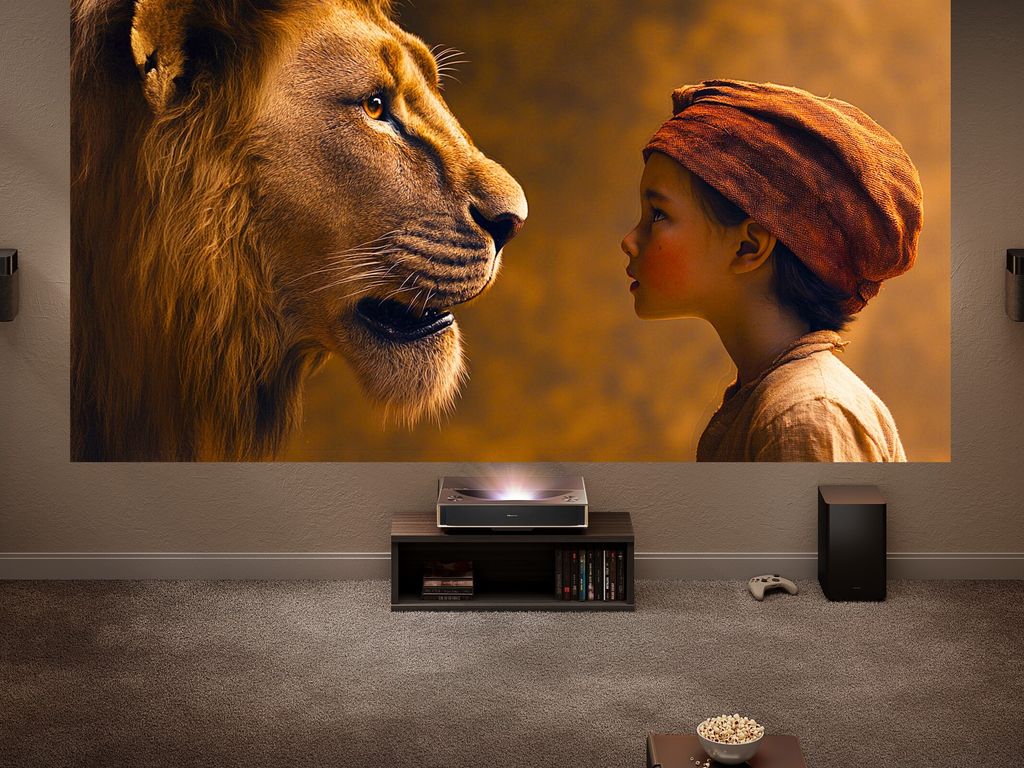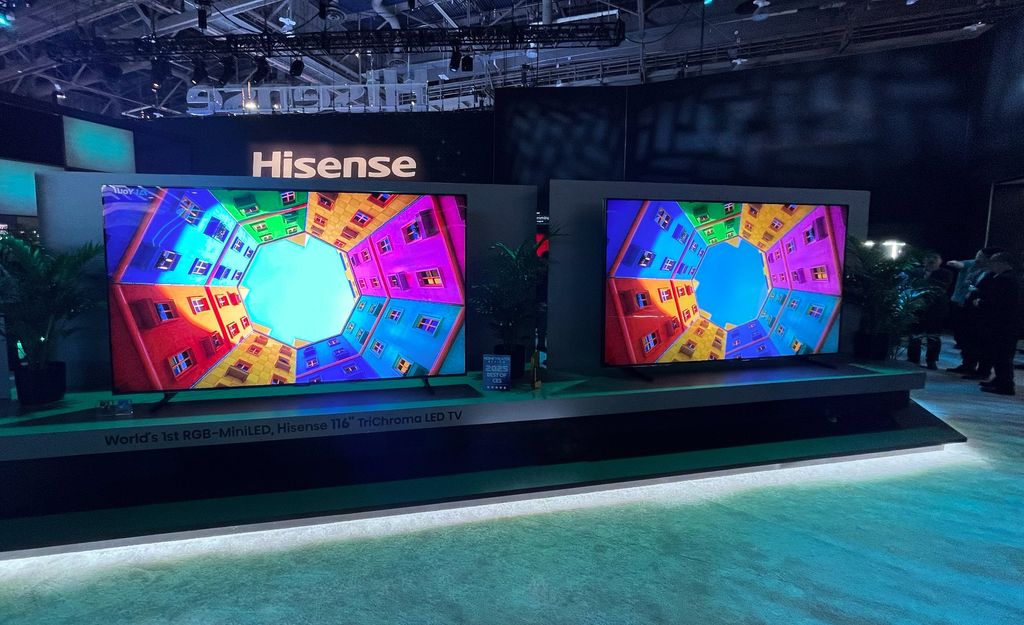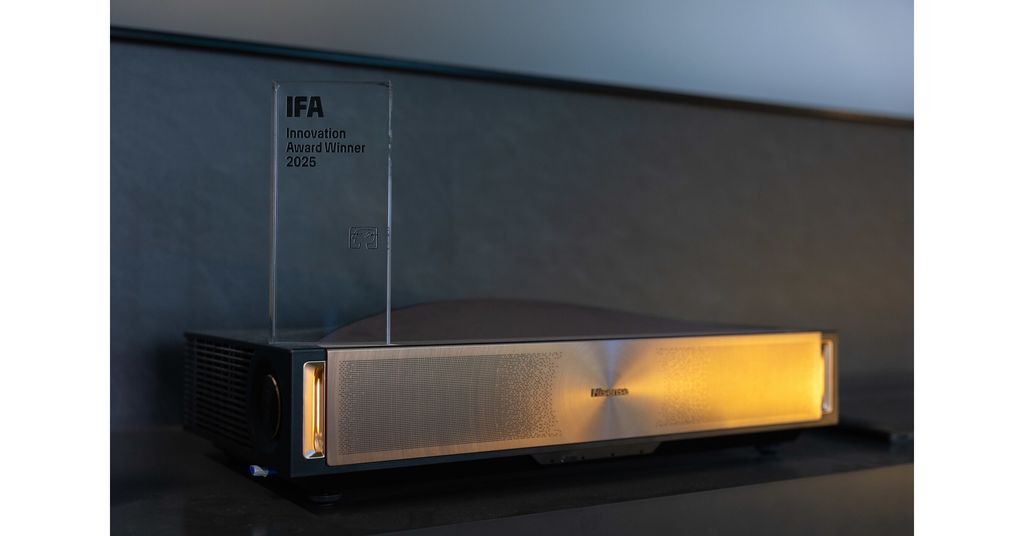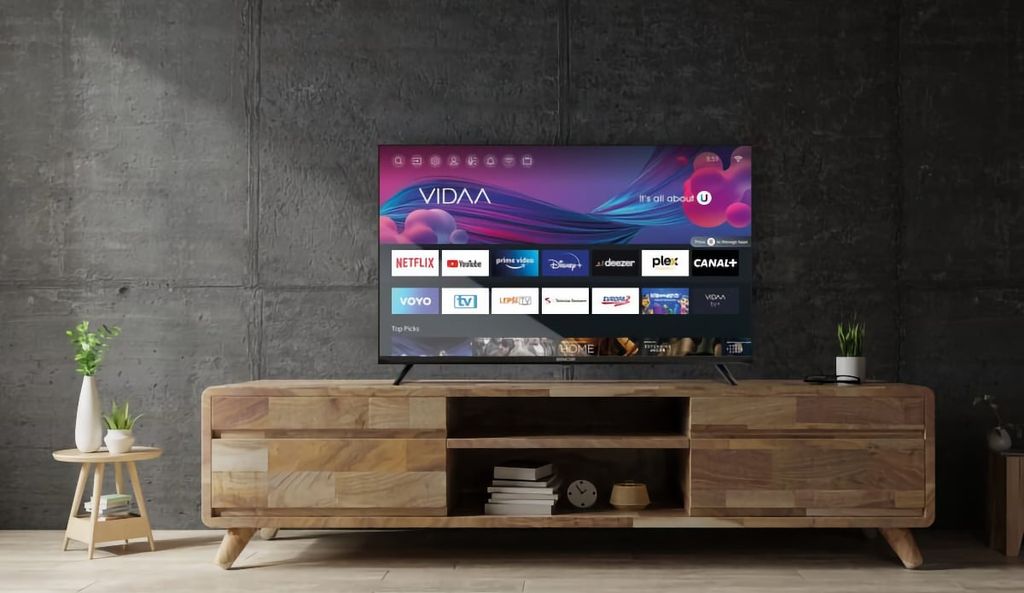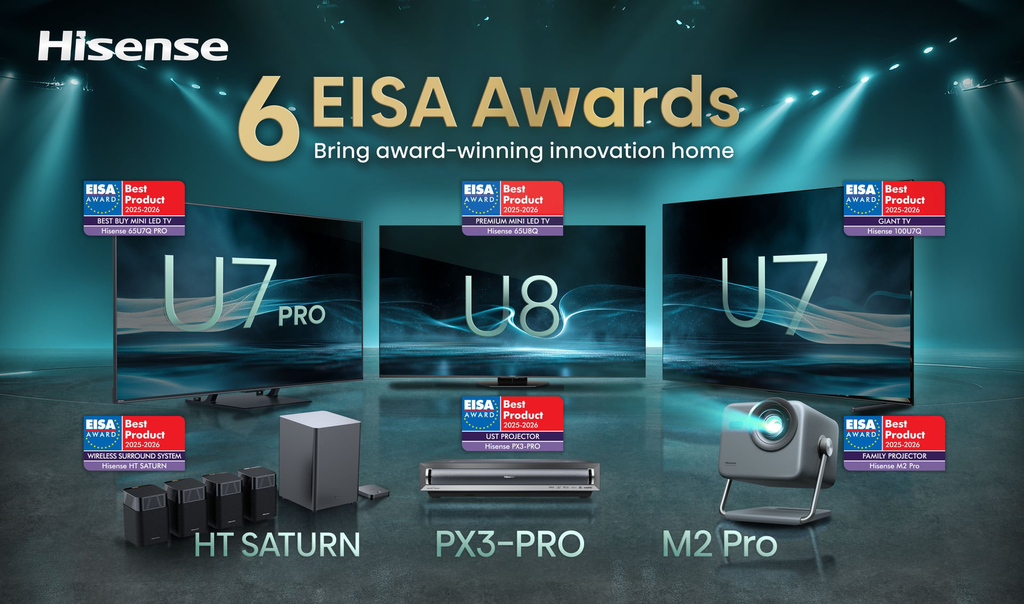- Matching (Score)
- Our verdict
- Competing TVs
- TV appearance
- Where to buy
- Contrast and black detail
- HDR effect quality
- Factory color reproduction
- Color reproduction after calibration
- Smoothness of tonal transitions
- Image scaling and smoothness of tonal transitions
- Blur and motion smoothness
- Console compatibility and gaming features
- Input lag
- Compatibility with PC
- Viewing angles
- Daytime performance
- TV features
- Apps
- Playing files from USB
- Sound
- Panel details
Hisense E7Q / E79Q Review
E7Q / E79Q
Available screen sizes:
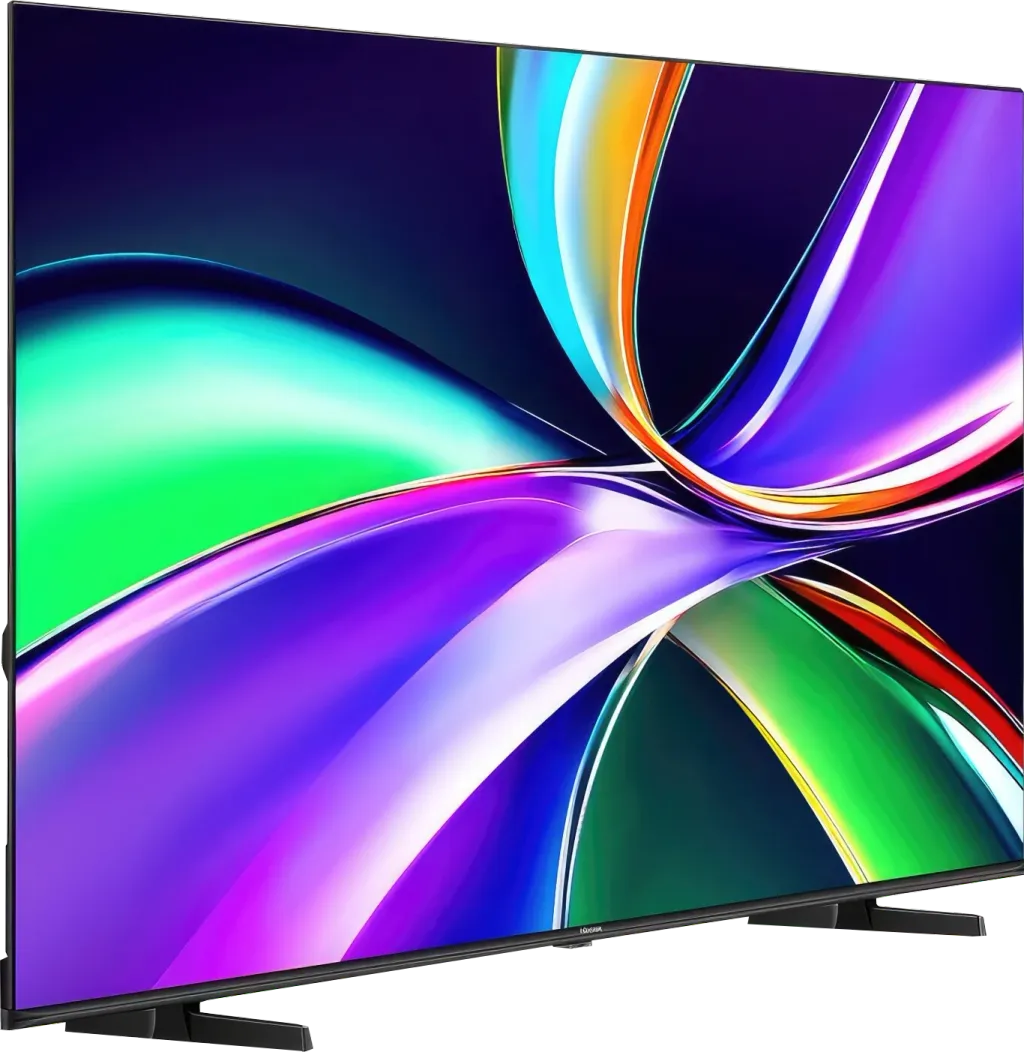
Complete the survey to find out the result
Panel type: LCD VA Refresh rate: 60Hz Brand: HISENSE Resolution: 3840x2160 System: VIDAA Model year: 2025
When buying a television at a reasonable price, most of us know that we won't be getting miracles – but sometimes it’s enough for the equipment to simply function well. It should have pleasant colours, sensible motion fluidity, and not spoil the evening viewing experience. The Hisense E79Q seems to be just such a model: a reasonably priced QLED that aims to offer a bit more than the typical supermarket television. There are a few nice surprises here – such as the 120 Hz mode for gamers, which improves motion fluidity in dynamic scenes. This is not equipment with ambitions for home cinema, but it’s also not a screen "for the kitchen." Rather, it’s a thoughtful compromise, where the manufacturer has tried to squeeze the maximum out of a limited budget. How did they do it? We checked.
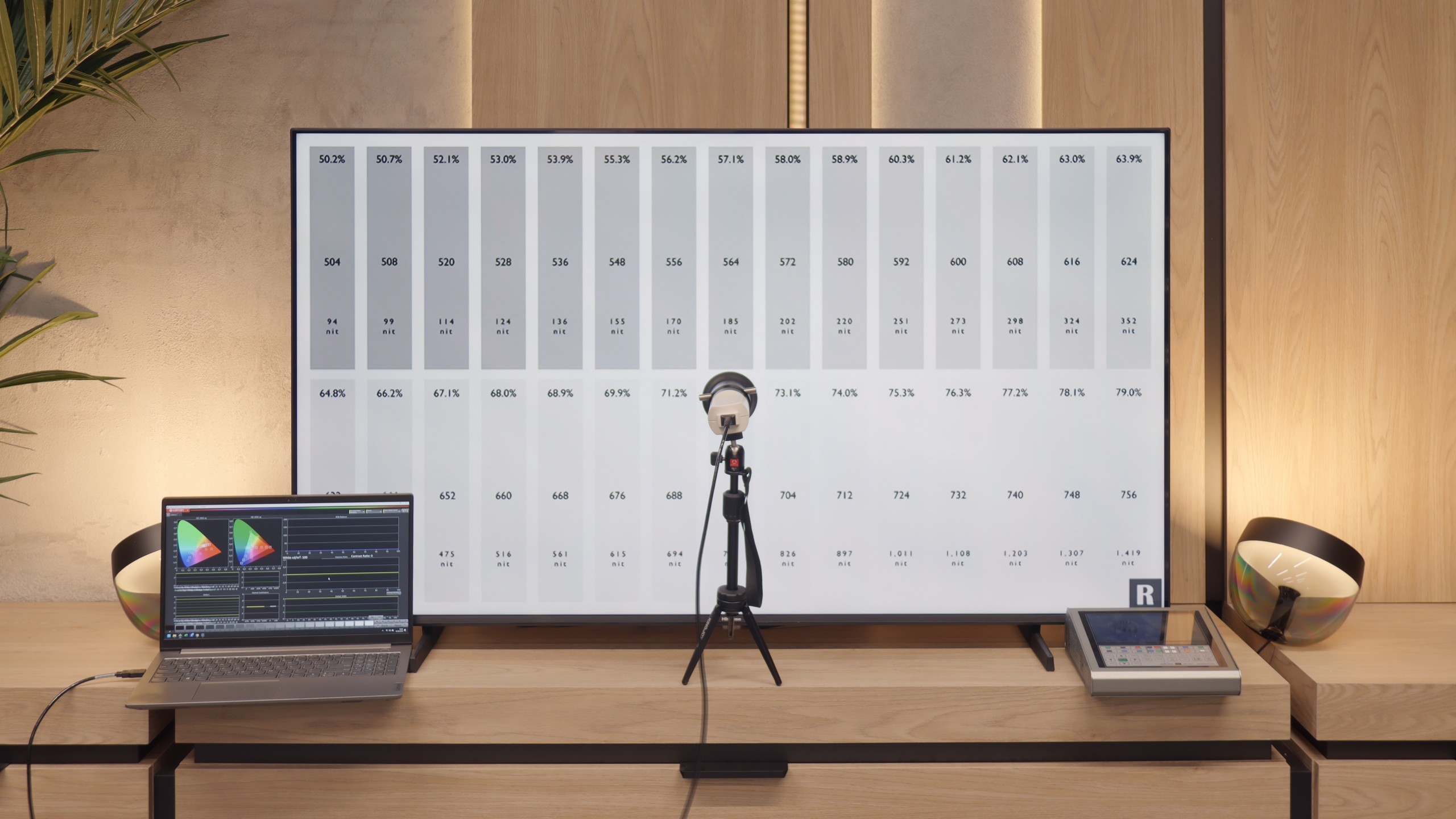
HISENSE E7Q / E79Q - Our verdict
6.1
Overall rating
The Hisense E7Q / E79Q is a type of television that does not promise miracles – and maybe that’s why it can pleasantly surprise. It doesn’t try to pretend to be high-end equipment, it just does its job. If you are looking for a cheap screen for everything, that can handle Netflix, a console, and early morning YouTube with coffee, then this model makes a lot of sense. The VIDAA system has been maturing for several years, and it shows that the manufacturer is drawing conclusions. We have AirPlay, screen mirroring, voice search in Polish – everything works, maybe not at lightning speed, but smoothly enough not to be irritating. You won’t find thousands of apps like in Google TV, but the most important ones are at hand. It’s a system meant to be simple and practical, rather than overloaded with unnecessary gimmicks – and in that sense, it really holds up. There’s something interesting for gamers too. The E7Q / E79Q offers low input lag, an automatic low latency mode (ALLM), support for VRR up to 60 Hz, and even a 120 Hz mode in 1080p resolution. This is not a screen for hardcore e-sports enthusiasts, but if you simply enjoy firing up the console in the evening and playing a few rounds, this television will do its job without complaint. And how about the picture quality? We won’t deceive you – it’s not spectacular, but there are also no reasons to complain. A brightness level of around 350 nits won’t impress, however, the contrast thanks to the VA panel can really surprise positively. The black is quite deep, and the colours have a pleasant intensity, especially in SDR mode. It’s a bit of a shame that Dolby Vision adds little – because if it worked as it should, we would have a television that could confidently be recommended for HDR viewing as well. On the other hand, it’s hard to expect that in this price range. It’s simply a fair, well-priced screen that doesn’t try to be a star, but is capable of delivering solid picture quality and surprisingly good features. And although it’s not perfect, after a few days of use, it’s hard not to think: “Wow, this cheap Hisense really does deliver.”
Advantages
Good black and contrast
QLED (PFS LED) – vibrant and saturated colours, coverage of the DCI-P3 palette around 92%
Many features for gamers: ALLM, VRR, Low input lag, Game Bar
120Hz support at 1080p!
VIDAA system – easy to use, with AirPlay, Screen Mirroring, and voice search
Recording to USB from built-in tuners
3.5 mm jack output and component inputs for older devices
Support for many audio formats including Dolby Atmos and DTS:X
Attractive price
Disadvantages
Dolby Vision adds little (which is a shame)
Poor digital image processing: lack of image enhancement features, average upscaling
Strong dithering when connecting to a PC (coloured fonts)
The build quality of our unit was very average
Movies and series in UHD quality
6.2
Classic TV, YouTube
5.9
Sports broadcasts (TV and apps)
5.1
Gaming on console
7.1
TV as a computer monitor
3.0
Watching in bright light
5.2
Utility functions
8.7
Apps
7.7
Sound quality
6.3
Complete the survey to find out what fits your preferences
HISENSE E7Q / E79Q - Competing TVs in this price range
HISENSE E7Q / E79Q - TV appearance
HDMI inputs: 3 x HDMI 2.0, 0 x HDMI 2.1 Other inputs: Component (YPbPr) Outputs: Toslink (Optical audio), eARC (HDMI), ARC (HDMI), Mini-Jack (Headphones) Network Interfaces: Wi-Fi 2.4GHz, Wi-Fi 5GHz, Ethernet (LAN) 100Mbps
Build quality: Budget
Stand type: Legs
Bezel color: Graphite
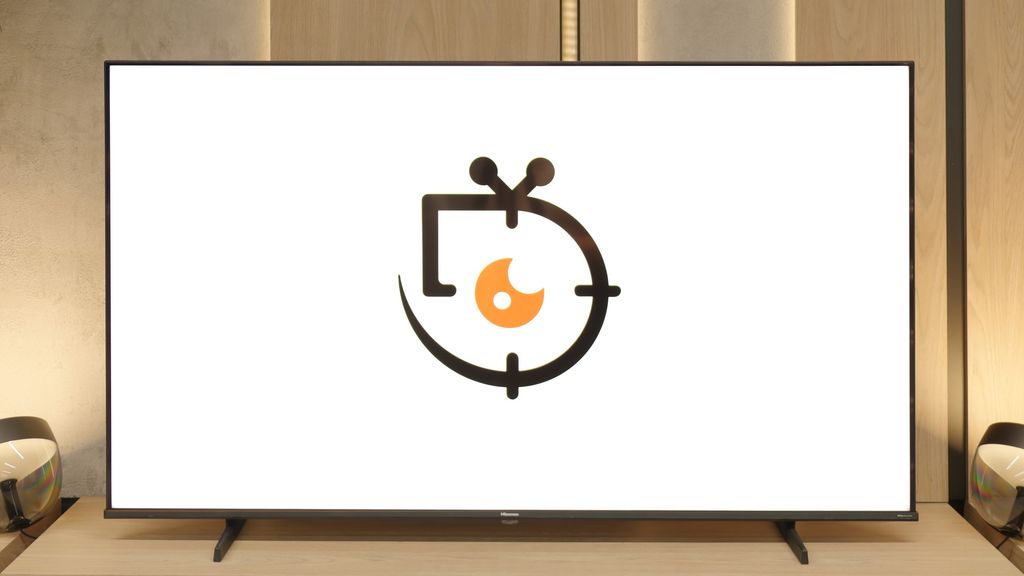
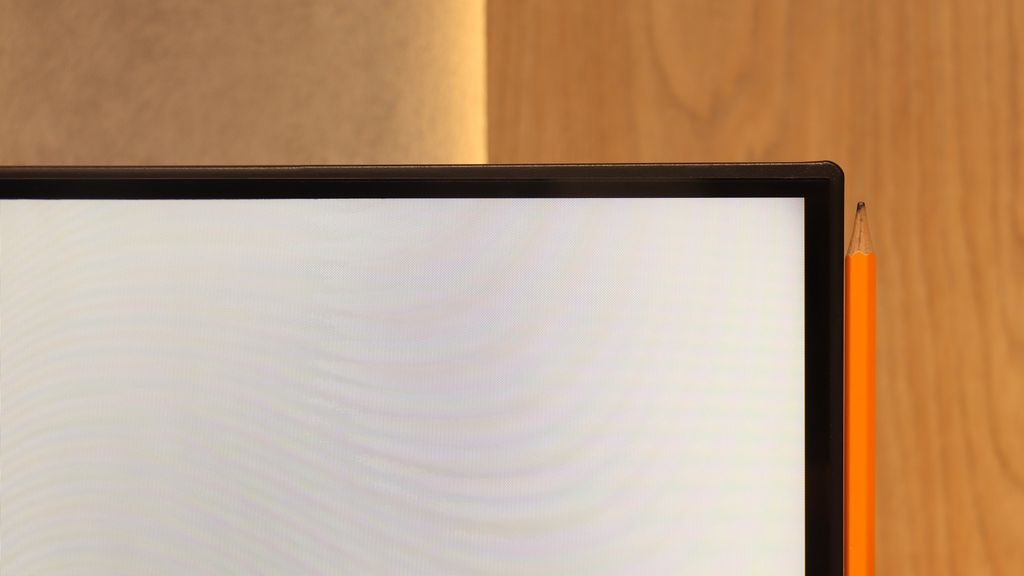
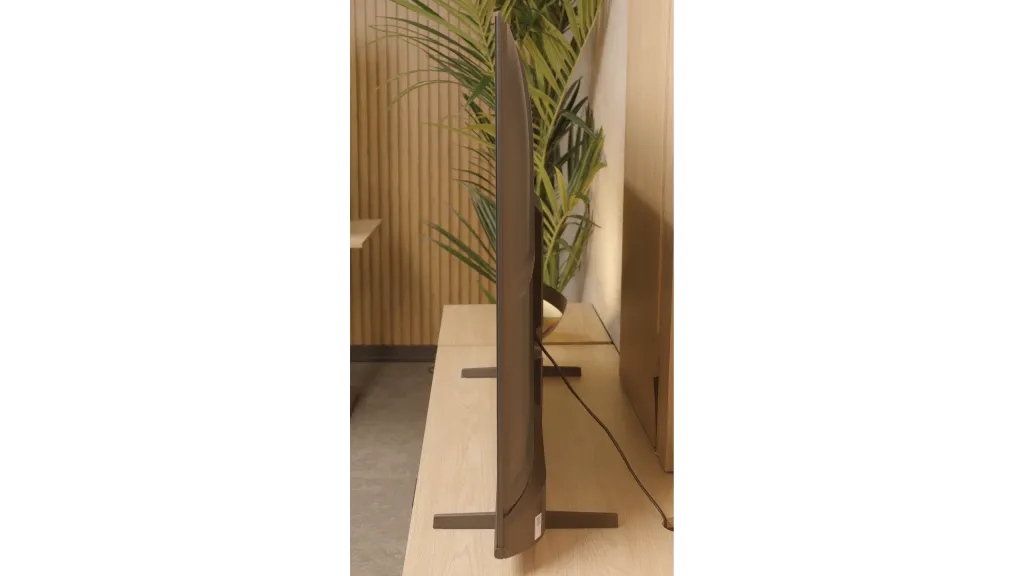
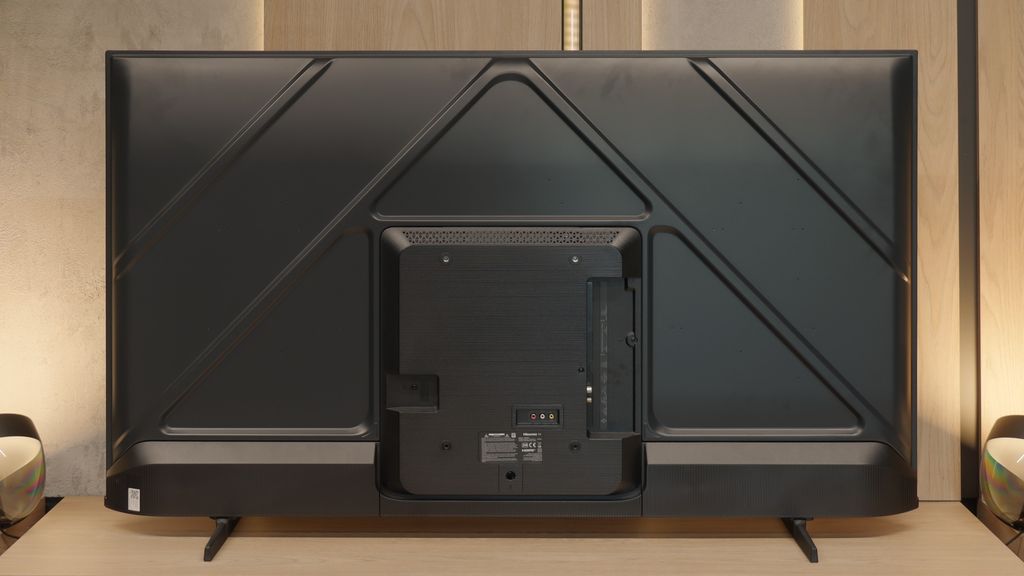
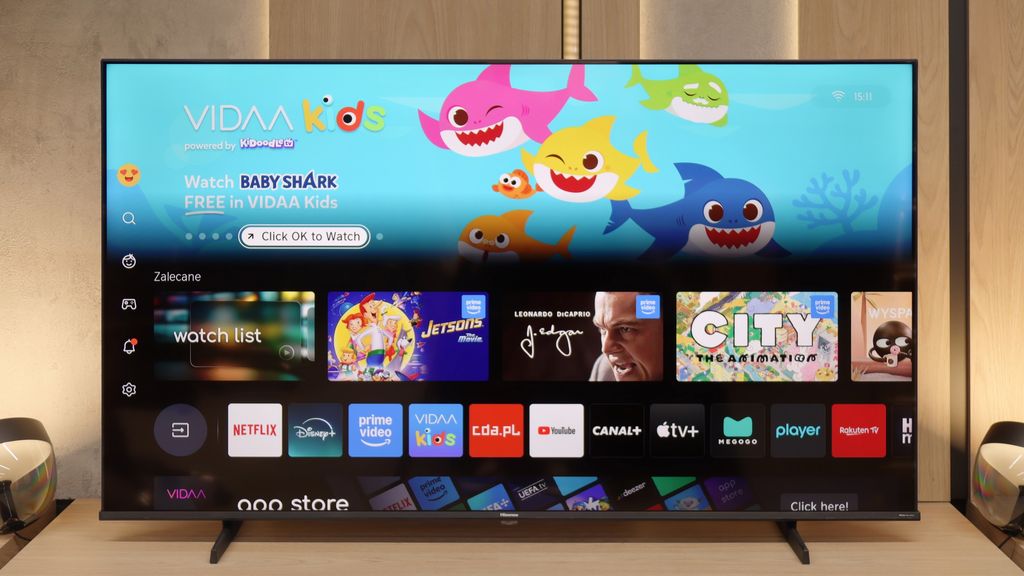
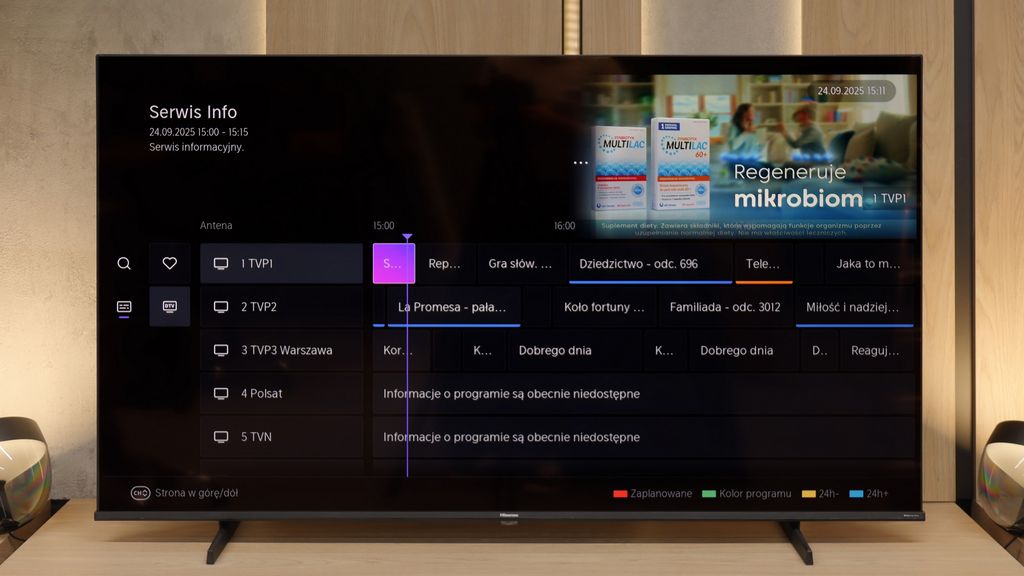
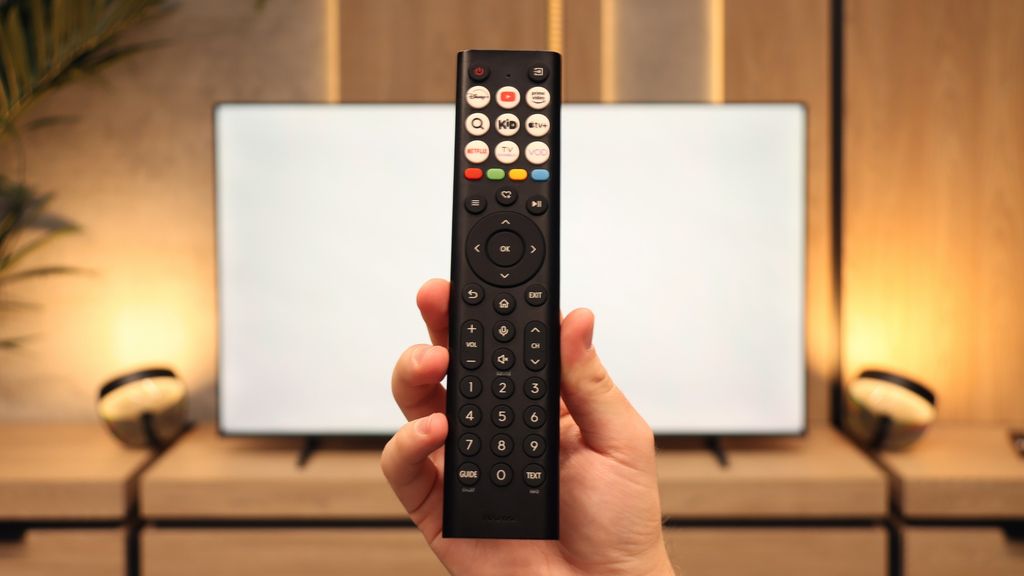
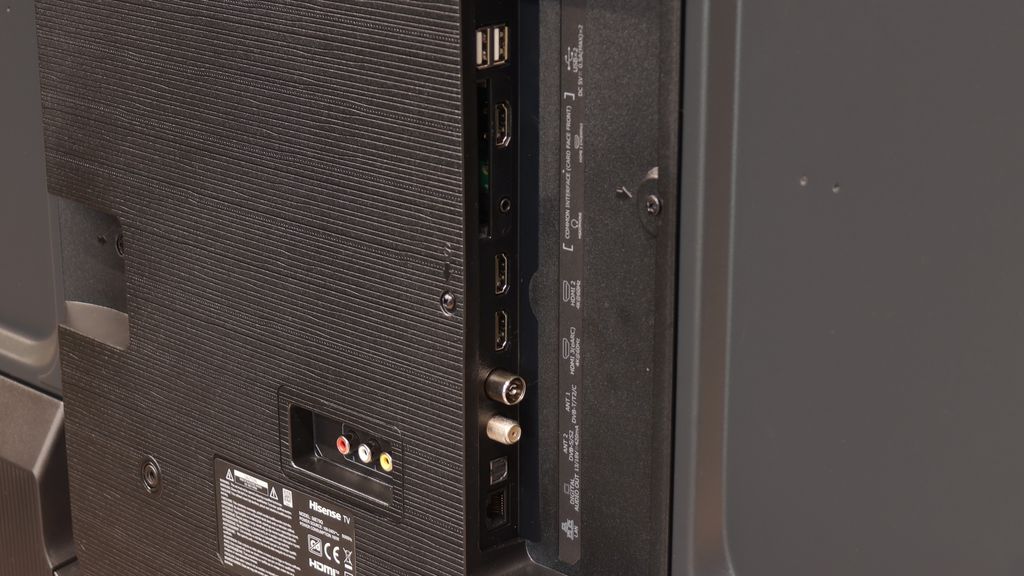
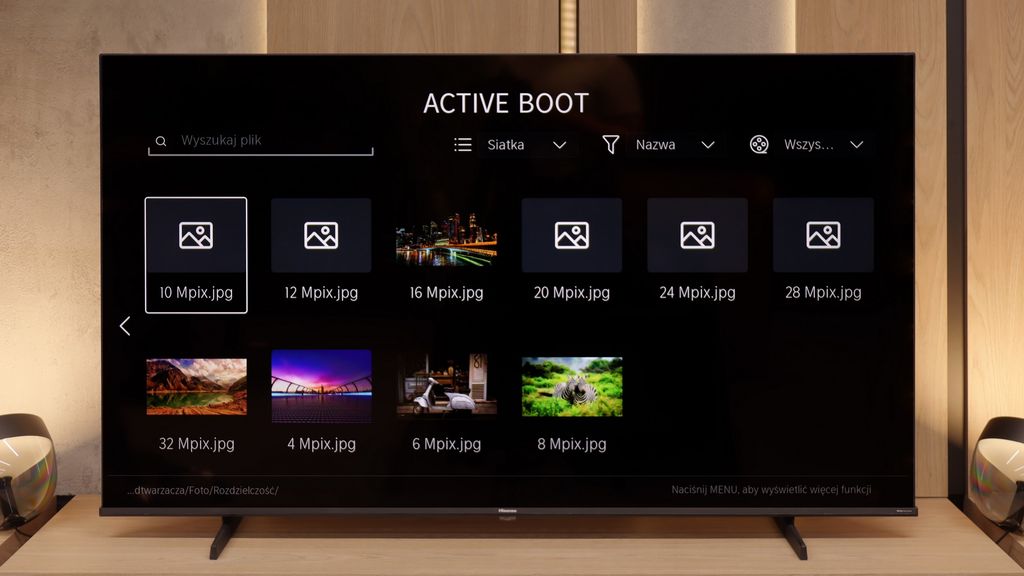
Stand: Fixed
Flat design: No
Accessories: Stand
The Hisense E7Q / E79Q is a television that reveals its budget origins at first glance. Indeed, the frame is slim and elegant, but the quality of the workmanship does not make the best impression. In our test sample, the screen protruded significantly above the frame, which gave us considerable concern when removing the screen from the box. This may be a defect of the specific unit that arrived at our laboratory, but it is difficult not to take this into account. When we look at the back of the television, the impression of cheapness only deepens. It is made from a single, stamped panel, which, although solid, simply looks average. The entire construction is also quite thick, so it is definitely far from the "slim" category. From the front, the television looks really quite good, but there are a few "blunders" that the manufacturer should address.
Buy at the best price
Select size:
HISENSE E7Q / E79Q - Contrast and black detail
5.7/10
Local dimming function: No

Result
5,400:1

Result
5,450:1

Result
3,800:1

Result
5,000:1

Result
4,350:1
Visibility of details in the lights:
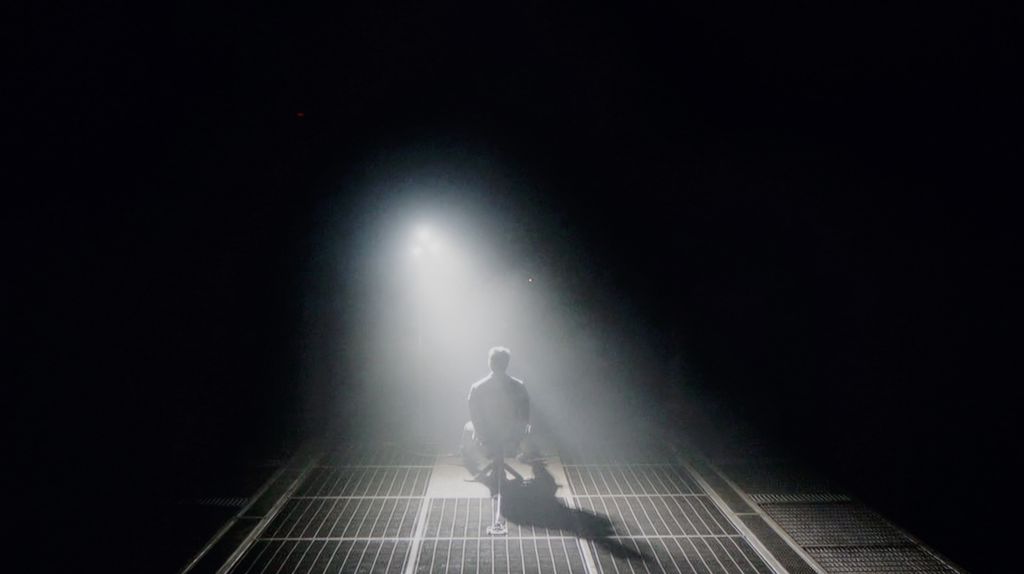
The Hisense E7Q / E79Q in our test variant of 58 inches is equipped with a VA-type panel, which has a huge impact on the perception of contrast and black levels in films and series. Thanks to such a panel, one can expect decent contrast and a stable visual effect, which works really well in most scenes. In our measurements, we achieved values approaching around 6000:1, which should be considered a solid result in this price range. However, it is important to remember that this is not a design with local dimming, so one cannot expect the deep, "pitch-black" blacks known from more expensive models. In some shots, the black can have a slightly navy hue, which is completely natural with this technology and price. This, however, is a compromise that does not detract from everyday viewing – especially if we watch in the evening with slightly dimmed light.
Halo effect and black detail visibility:
HISENSE E7Q / E79Q - HDR effect quality
5.1/10
Supported formats: HDR10, Dolby Vision Color gamut coverage: DCI P3: 91.4%, Bt.2020: 73.2%
Luminance measurements in HDR:

Result
300 nit

Result
329 nit

Result
379 nit

Result
389 nit

Result
397 nit
The Hisense E7Q / E79Q is a television with average brightness, with a peak luminance level of around 350-380 nits. This is an absolute minimum that allows for HDR content to be viewed in a way that is close to the creators' intentions, although without a distinct "wow" effect. Synthetic test results on white screens have been confirmed in practice – in film scenes, the bright parts of the image are stable and quite uniform, but it's hard to speak of a true "light punch." In everyday use, for example, when watching Netflix or YouTube, the HDR effect is acceptable and is perfectly sufficient for most users. However, it must be stated clearly – this is not the level of top-end screens, and one should not expect that in this price range. Fortunately, the Hisense E7Q / E79Q has an advantage that allows it to gain quite a few points: it features a PFS LED QLED panel, utilising an additional phosphor layer that improves colour reproduction. The measured range of the DCI-P3 colour gamut is about 92%, which means that colours in most scenes are vibrant, well-saturated, and pleasant to the eye, particularly for this price bracket.
Scene from the movie “Pan” (about 2800 nits)

Scene from the movie “Billy Lynn” (about 1100 nits)

During the tests of the Hisense E7Q / E79Q, we traditionally decided to set aside synthetic charts and focus on how the television performs in the real cinematic world. For although the numbers can be ruthless, it is ultimately the emotions and the impression of image coherence that determine whether a given screen will remain in our living room for longer. In the case of the E7Q, it is hard to speak of surprise – it is a typical example of a television that does not lose detail, but due to limited brightness displays everything just a bit too brightly. The black loses depth, which makes a cinematic night start to resemble an evening by street lamps. This is not an effect of clipping, rather a subtle "lightening of everything" that takes away character from the image. In scenes with fireworks or flashes of headlights, details remain visible, though the bright areas can be overly aggressive. The darker areas, on the other hand, glow slightly, reminding us that we are not dealing with a screen equipped with local dimming technology, let alone an OLED. Colours can also be capricious – faces become redder, and the overall tone leans towards purple, causing the image to sometimes appear "too theatrical". This is not a television that will deceive the eye of an experienced viewer. But in everyday use, with soft lighting and evening Netflix, it can create quite a pleasant atmosphere.
HDR luminance chart:
HDR luminance
The comparison between HDR10 and Dolby Vision for the Hisense E7Q / E79Q can be quite surprising – unfortunately in not a very positive way. Typically, in such inexpensive televisions with basic LCD backlighting, the use of dynamic metadata, especially in the Dolby Vision format, actually makes a difference – it improves contrast, reveals more details, and makes the picture look more mature. However, here the effect is surprisingly weak. Yes, there is a slight improvement in contrast, but that's about it. There are no greater amounts of detail, and the entire image remains very similar to that of HDR10. Dolby Vision works, but it appears as if the television simply cannot take advantage of its capabilities. It's a pity, as the potential was significant, but the end result is rather disappointing.
Static HDR10

Dynamic: Dolby Vision

Factory color reproduction
5.2/10
In Filmmaker mode, the Hisense E7Q / E79Q television was truly impressive. After the first measurements, it became clear that the white balance was quite well tuned, with the only minor deviation being a slight tendency towards a purple tone, which we mentioned earlier. However, this did not significantly impact the overall character of the image – it remained coherent and pleasant to view. A much larger issue turned out to be the brightness characteristics (gamma) in SDR content and the EOTF curve in HDR films. The television noticeably brightened the image, flattening the contrast and diminishing its depth. Gamma values could drop from the reference 2.4 to around 1.9, making the image look as if it were covered with a thin, milky layer. Fortunately, this is a problem that can be relatively easily corrected through calibration.
Color reproduction after calibration
7.4/10
The biggest beneficiary of calibration in the case of the Hisense E7Q / E79Q was undoubtedly the SDR mode. It managed to achieve an almost perfect image – most errors in the Color Checker test dropped below a value of 3, and often even 2, which is an outstanding result for this class of equipment. The greatest improvement came from equalising the brightness characteristic (gamma), which meant the image no longer appeared washed out and regained its natural depth. In HDR content, it was also possible to improve colours and eliminate the purple tint mentioned earlier, but errors in the Color Checker measurements were still noticeable. This is due to the fact that – as is often the case with Hisense televisions – the screen manipulates brightness quite heavily, overemphasising some colours. This was also indicated by the EOTF curve, which was slightly above the reference values, suggesting these minor issues with excessive brightness. Despite this drawback and the design limitations that emerge with HDR content, the Hisense E7Q / E79Q gained quite a lot after calibration. In everyday use, the television presents a consistent, natural, and pleasant image, and the difference compared to the factory settings is enormous.


HISENSE E7Q / E79Q - Smoothness of tonal transitions
8.5/10
For such a budget television, the Hisense E7Q / E79Q performs really well with such a challenging element as the fluidity of tonal transitions. In most scenes, the colours blend together naturally, without noticeable jumps or artificial edges. Brighter parts of the image stand out particularly well – the transitions are smooth and pleasing to the eye. Minor issues only occur with very dark shades of grey, where slight banding can be noticed. However, this is a detail that does not affect the overall reception of the image. For a television in this range, the result is more than decent.


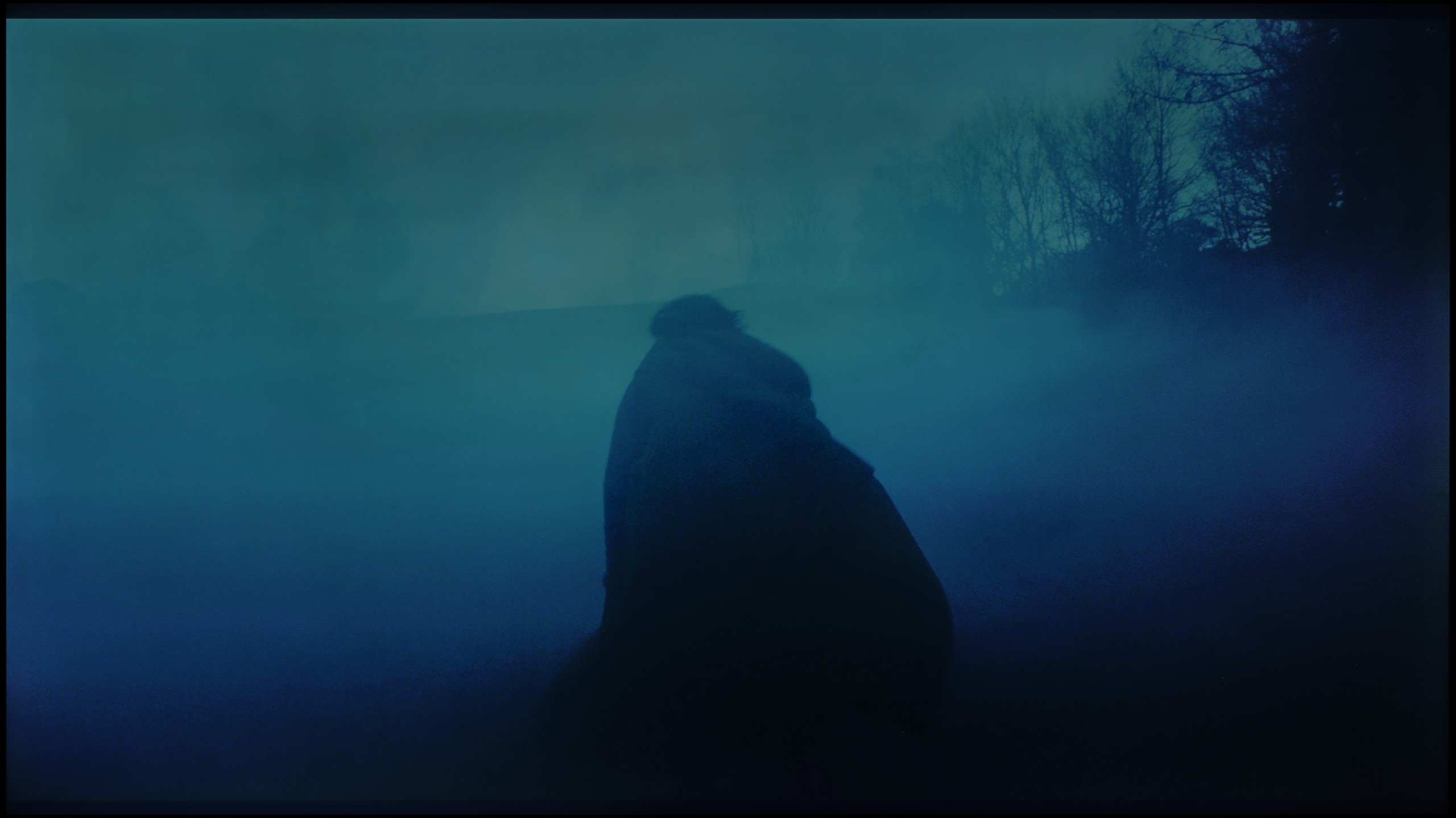





Image scaling and smoothness of tonal transitions
5/10
Smooth transition function
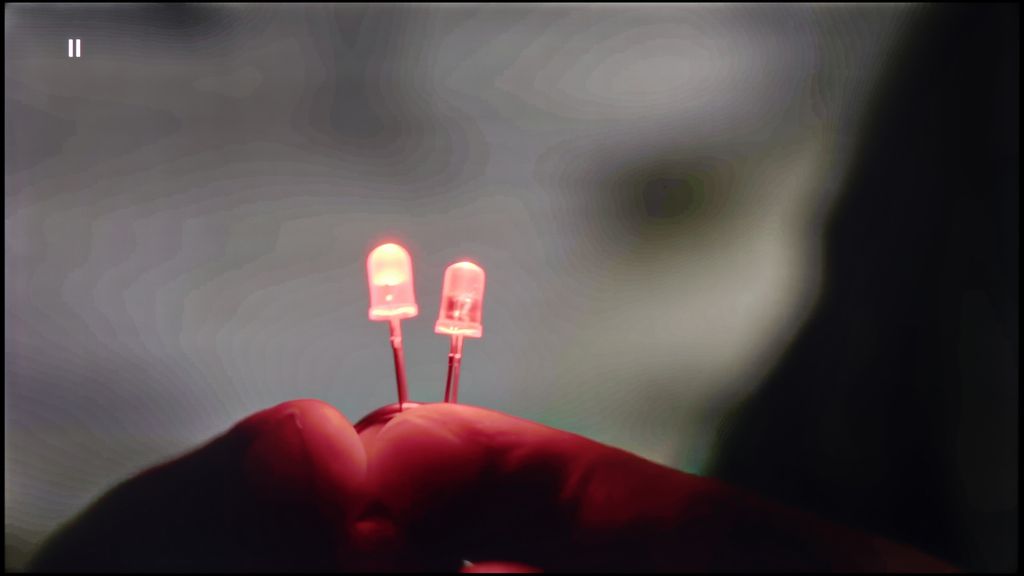
Image without overscan on the SD signal

In the case of the Hisense E7Q / E79Q, upscaling and digital image processing are not the strongest aspects of this television. It is evident that the manufacturer has opted more for simplicity rather than advanced image processing algorithms. The television does not offer any features to smooth tonal transitions or systems to improve image clarity, resulting in lower resolution materials looking simply very raw. On the screen, you can notice subtle compression edges that better processors in other models can effectively hide.
During the HD material tests, we noticed that the E7Q tries to artificially enhance detail, which sometimes works, and at other times has the opposite effect – the image becomes soft, slightly blurred, at times even “watery.” There is no aggressive sharpening that ruins naturalness, but there is also no finesse in the detail integration that better image converters offer.
HISENSE E7Q / E79Q - Blur and motion smoothness
4.8/10
Maximum refresh rate of the panel: 60Hz
Film motion smoothing option: Yes
Blur reduction option: No
BFI function 60Hz: No
BFI function 120Hz: No
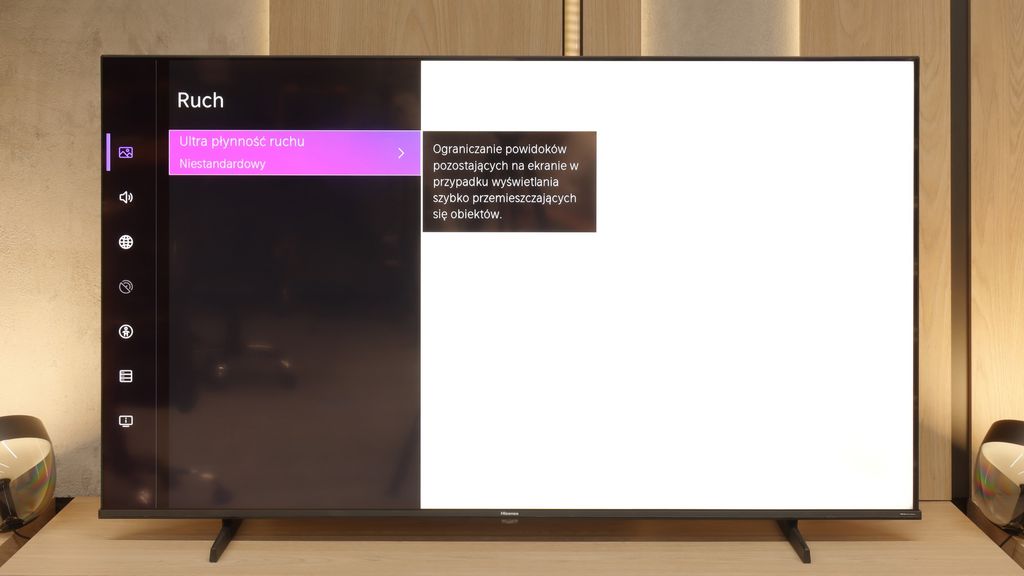
Hisense E7Q / E79Q is a television with a 60 Hz screen, so fans of 4K sports may feel a slight disappointment – we simply won’t see such smooth images here as in more expensive models with higher refresh rates. Fortunately, the situation is much better for films. Cinematic materials recorded at 24 frames per second can be displayed here using a motion smoothing feature, allowing the user to tailor the picture to their own preferences – either more cinematic with visible frames or smoother, in a theatrical style.
Blur (native resolution, maximum refresh rate):
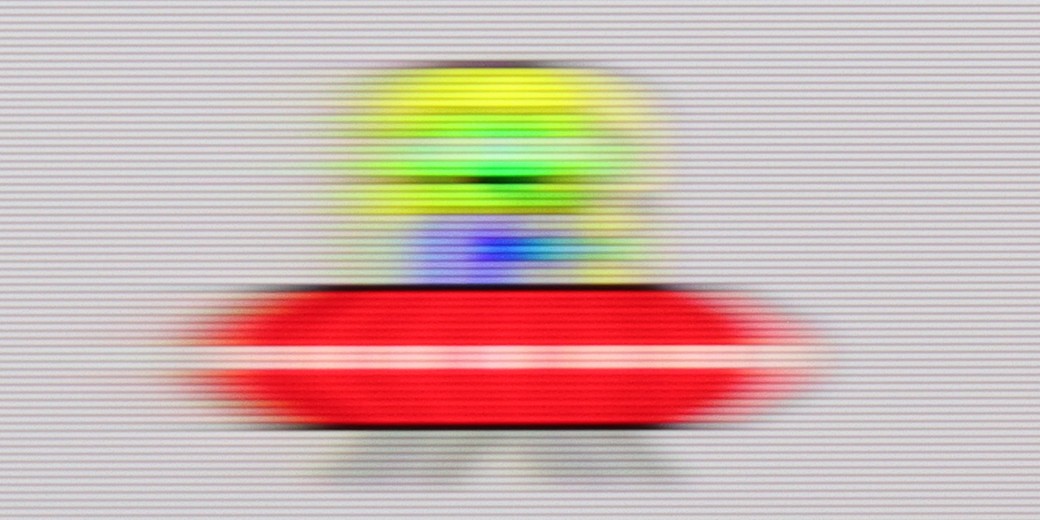
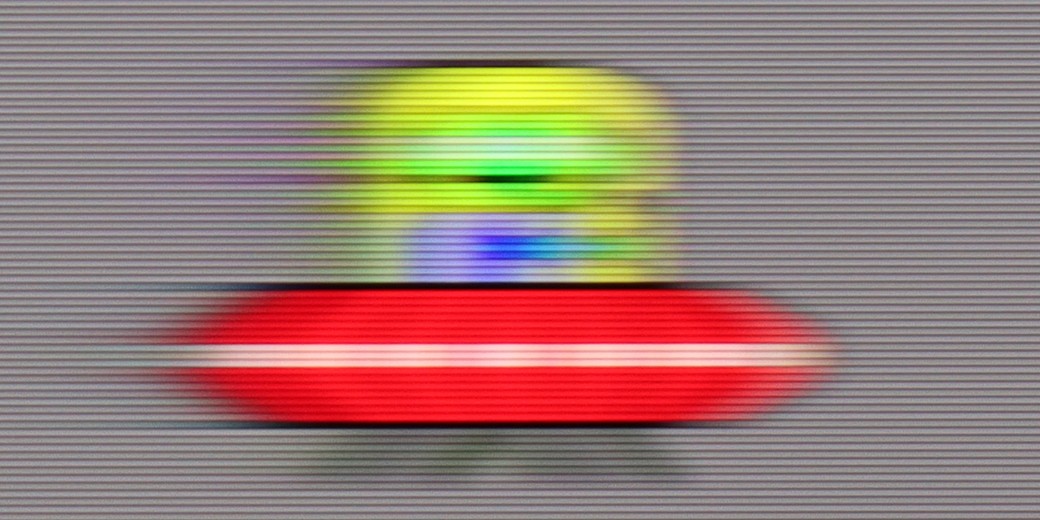
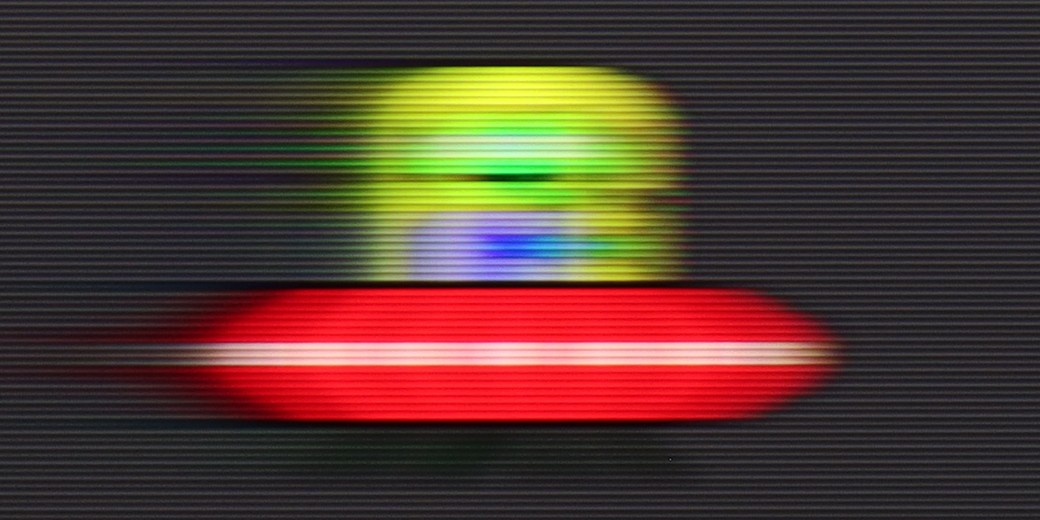
Blur (1080p@120Hz):

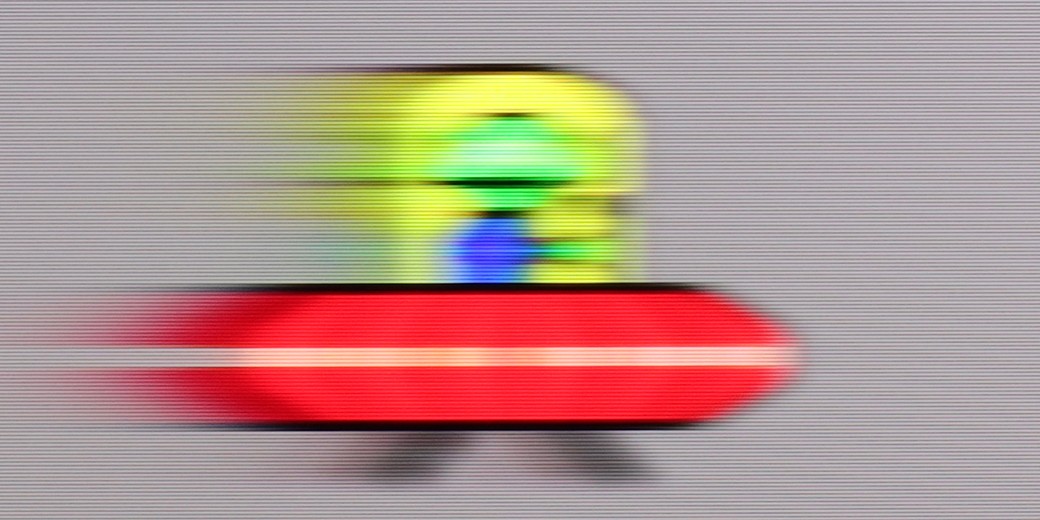
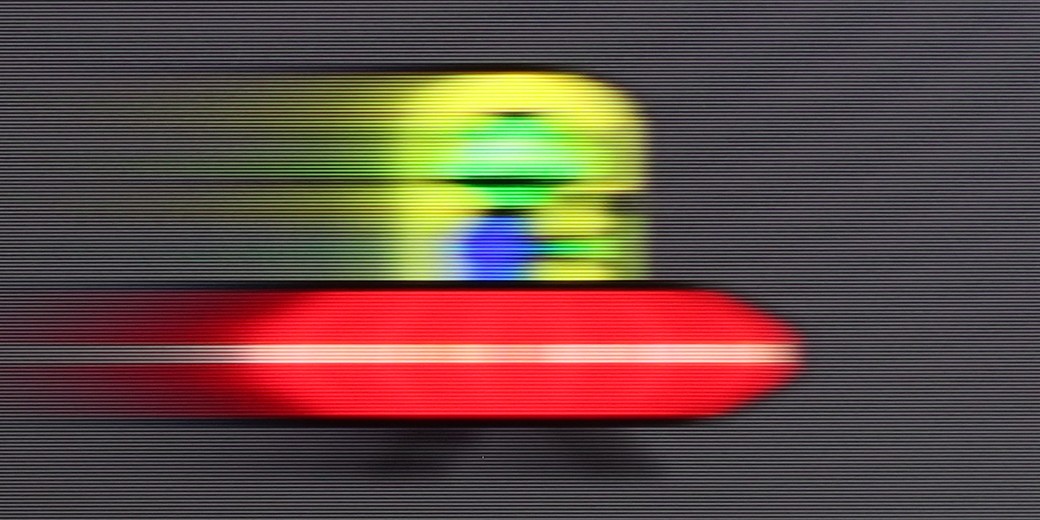
When it comes to ghosting and motion clarity, it is rather average. The used VA 60 Hz panel does not cope perfectly with fast motion – in our UFO test, ghosting is clearly visible, especially on darker elements of the image. On the positive side, the 120 Hz mode at 1080p resolution does bring a significant improvement in motion clarity. However, one must be aware that despite this, the image may still appear slightly blurred.
HISENSE E7Q / E79Q - Console compatibility and gaming features
6.3/10
ALLM: Yes
VRR: Yes
VRR range: 48 - 60Hz
Dolby Vision Game Mode: Yes
Correct implementation of HGIG: No
1080p@120Hz: Yes
1440p@120Hz: No
4K@120Hz: No
Game bar: Yes
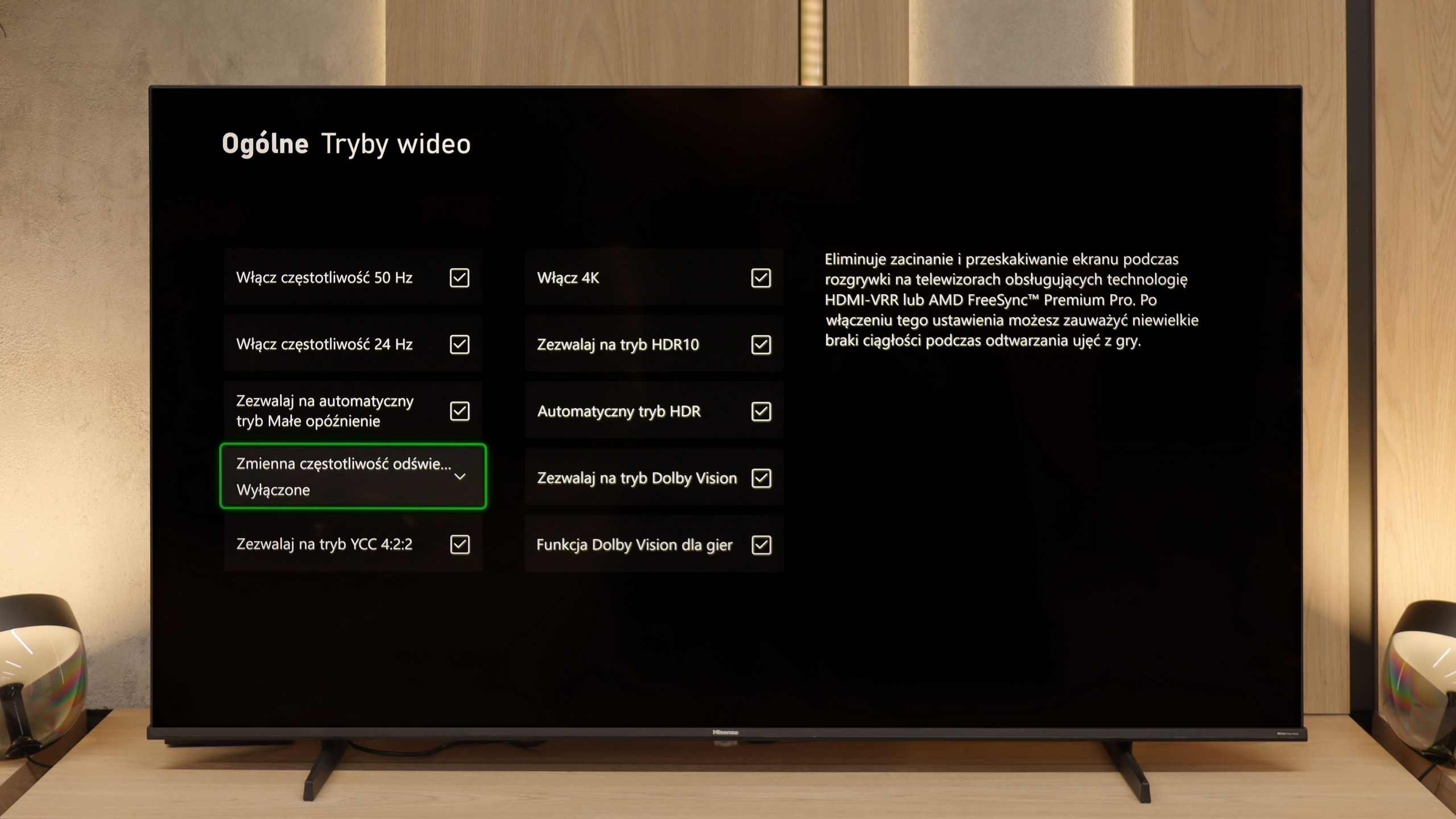
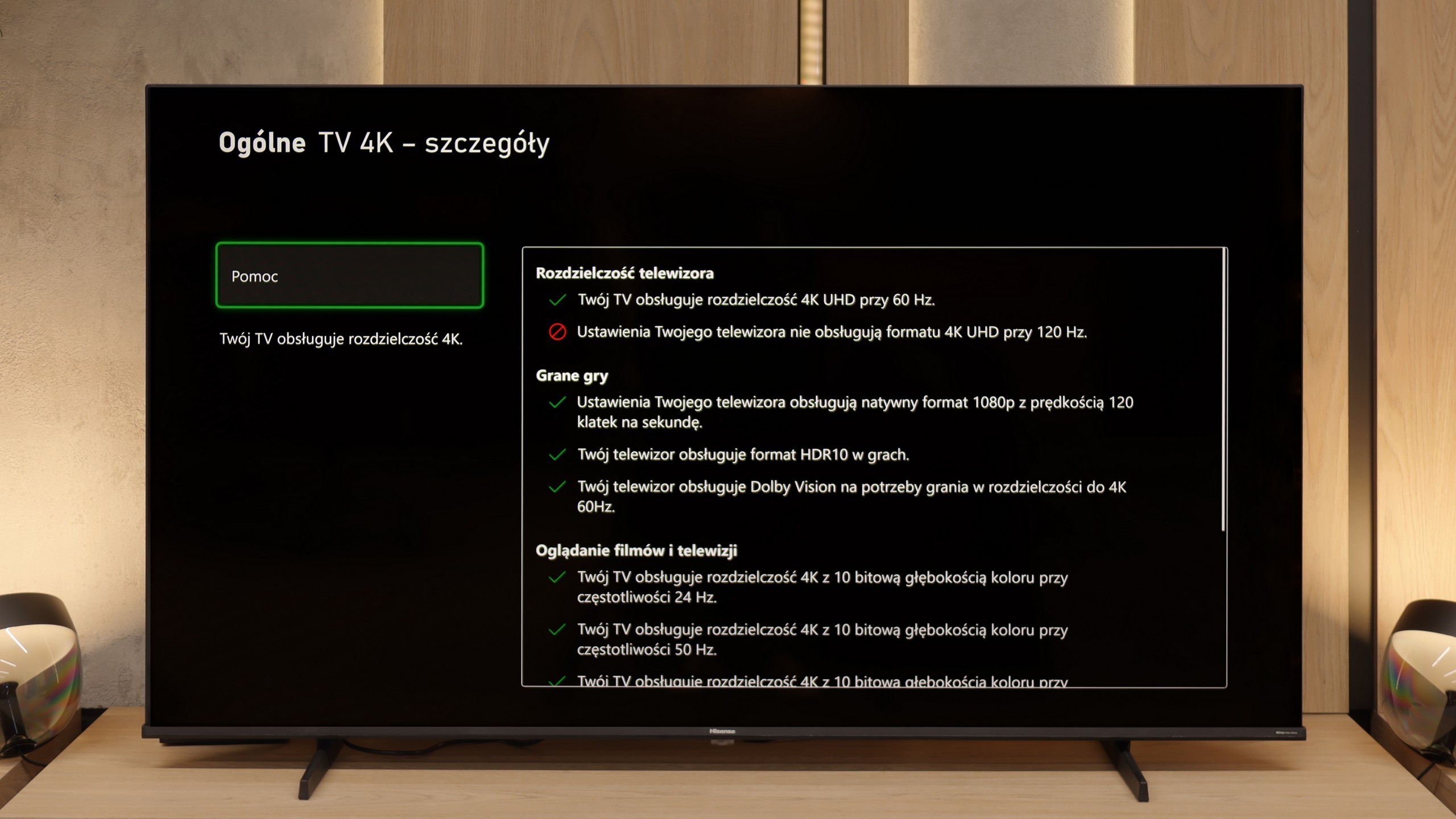
Hisense E7Q / E79Q is truly a successful television for gamers, even though it does not support 4K signal at 120 Hz. The manufacturer, however, has ensured a set of features that until recently could only be found in more expensive models. There is ALLM, meaning automatic switching to low latency mode, allowing the television to activate game mode with very low input lag by itself. We also have VRR, functioning up to 60 Hz – while this may not look impressive on paper, in practice it is fully sufficient, as most games on consoles do not exceed this limit. All these settings can be quickly found in the Game Bar panel, a convenient menu created specifically for gamers. From this interface, one can change picture modes, enable a frame counter, or even... an on-screen reticle – humorously named "target point" in the Vidaa system, which is a result of awkward translation from the Chinese manufacturer.
Special praise should be given to the ability to play in 1080p at 120 Hz, which significantly improves the fluidity and responsiveness of the image. Therefore, if someone wants to play a few titles at a higher refresh rate, they can simply lower the resolution and enjoy much smoother motion. Despite the lack of 4K@120Hz, the Hisense E7Q / E79Q performs really well as a gaming television – especially for those who are not looking for perfection but rather a solid and fast screen for everyday gaming.
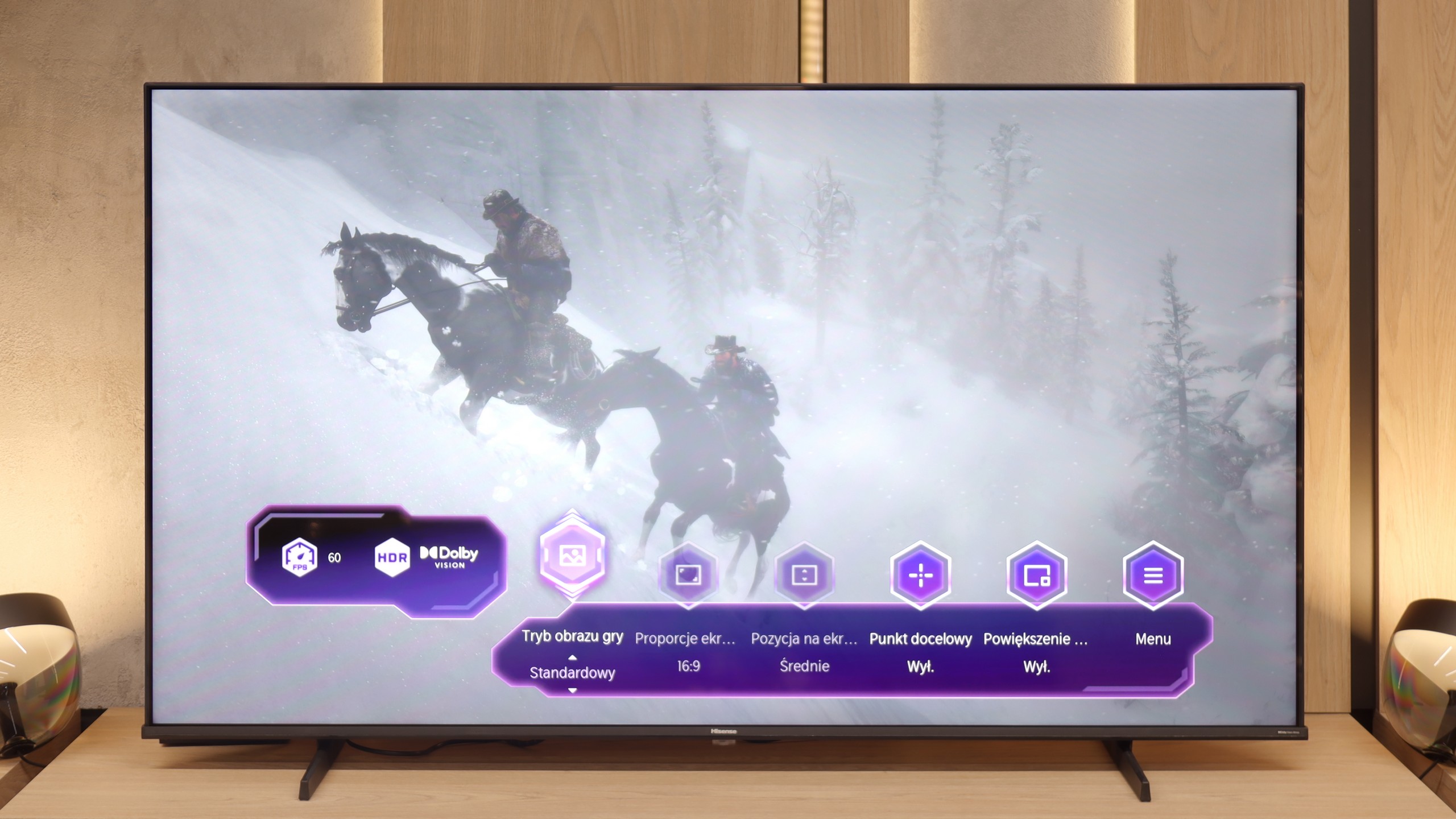
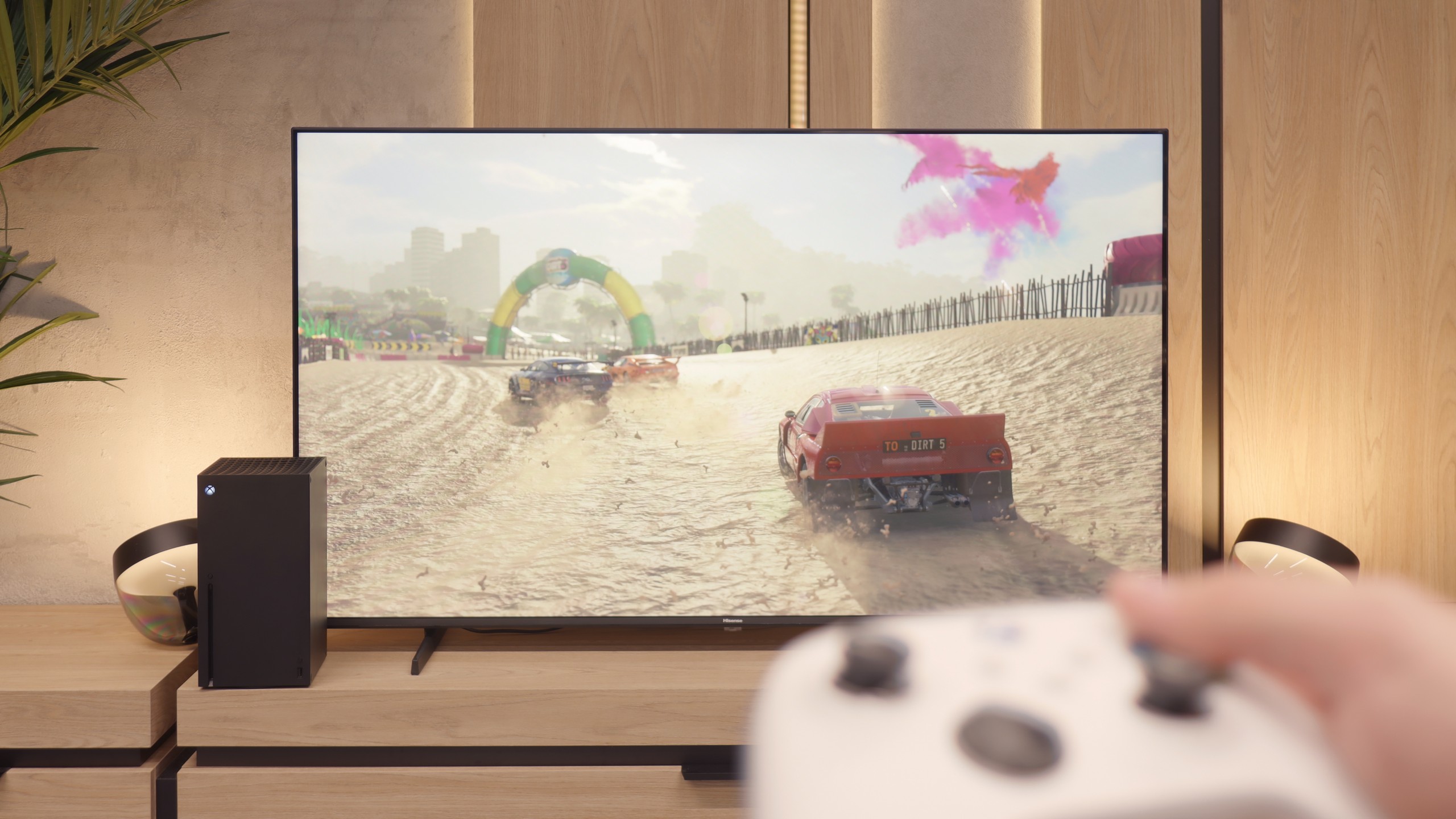

HISENSE E7Q / E79Q - Input lag
10/10
In games, the easiest thing to notice is how fast (or slow) the television is – and the Hisense E7Q / E79Q passes this test without a hitch. After just a few minutes of playing, you can feel that the response to the controller movements is instantaneous, without that characteristic delay that can ruin even the best match in FIFA or a crucial exchange in a fighting game. In game mode, the E7Q / E79Q operates with a delay of less than 15 ms, which means there is virtually no gap between pressing the button and the response on the screen. This is a level that more expensive models would be proud of. And it is precisely for this responsiveness – perhaps even more than for the picture or features – that this television truly deserves to be praised.
| SDR | HDR | Dolby Vision |
|---|---|---|
| 1080p60: 13 ms | 2160p60: 12 ms | 2160p60 DV: 12 ms |
| 1080p120: 8 ms | ||
| 2160p60: 12 ms |

HISENSE E7Q / E79Q - Compatibility with PC
3/10
Chroma 444 (maximum resolution and refresh rate): Yes
Font clarity: Good
Readability of dark text and shapes: Poor
Input lag in PC mode (4K, maximum refresh rate): 13ms
Matrix subpixel arrangement: BGR
Max refresh rate: 60Hz
G-Sync: Yes
When it comes to working with a PC, the Hisense E7Q / E79Q unfortunately does not impress. Yes, the television supports full 4:4:4 chroma sampling, so text and fonts are quite readable, but that is where the list of advantages pretty much ends. The screen has a significant issue with dithering, which in practice looks very unpleasant – as if the surface of the image subtly shimmered with colours. This is best seen with dark letters on a grey background – instead of neutral shades of fonts, there are delicate flashes of blue, green, and red, reminiscent of a rainbow effect. After extended use with a computer, this can strain the eyes and reduce comfort. On the plus side, one can note the presence of frame synchronization and the ability to operate at 120 Hz at a lower resolution, which may be a small consolation for gamers. However, as a typical monitor for PC use, the E7Q / E79Q performs rather mediocrely.
HISENSE E7Q / E79Q - Viewing angles
3.2/10
Brightness drop at an angle of 45 degrees: 73%
The Hisense E7Q / E79Q has typical VA panel weak viewing angles. Straight on, the image looks very good - the blacks are deep and the contrast is high. However, it only takes sitting slightly off to the side for the situation to change rapidly. At an angle of about 45 degrees, brightness drops by around 73%, and colours clearly lose saturation. This is the typical compromise we will have to accept for choosing a television with this type of panel instead of an IPS panel. With IPS, the viewing angles are much better, but the blacks are considerably worse.
HISENSE E7Q / E79Q - Daytime performance
5.2/10
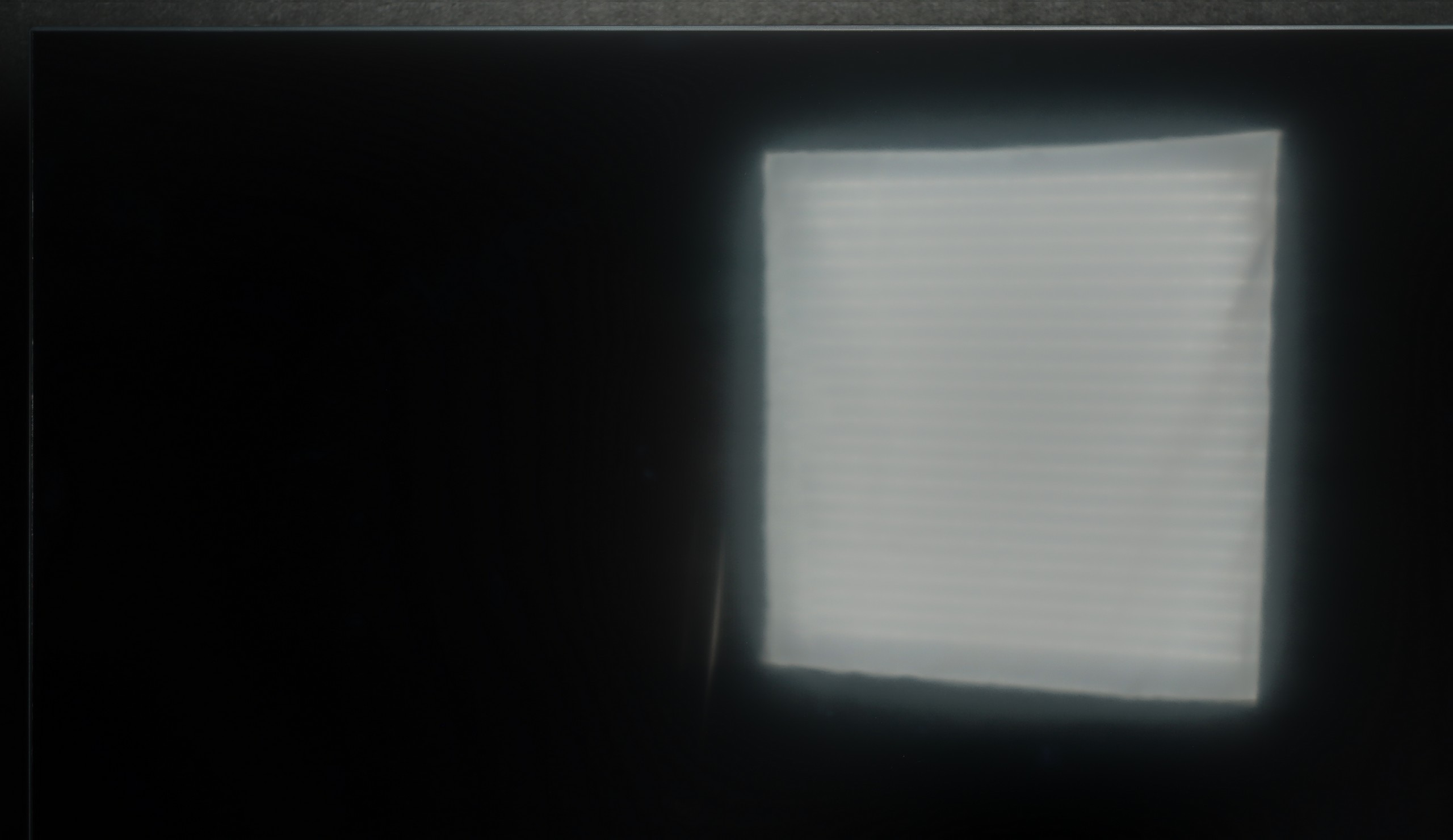
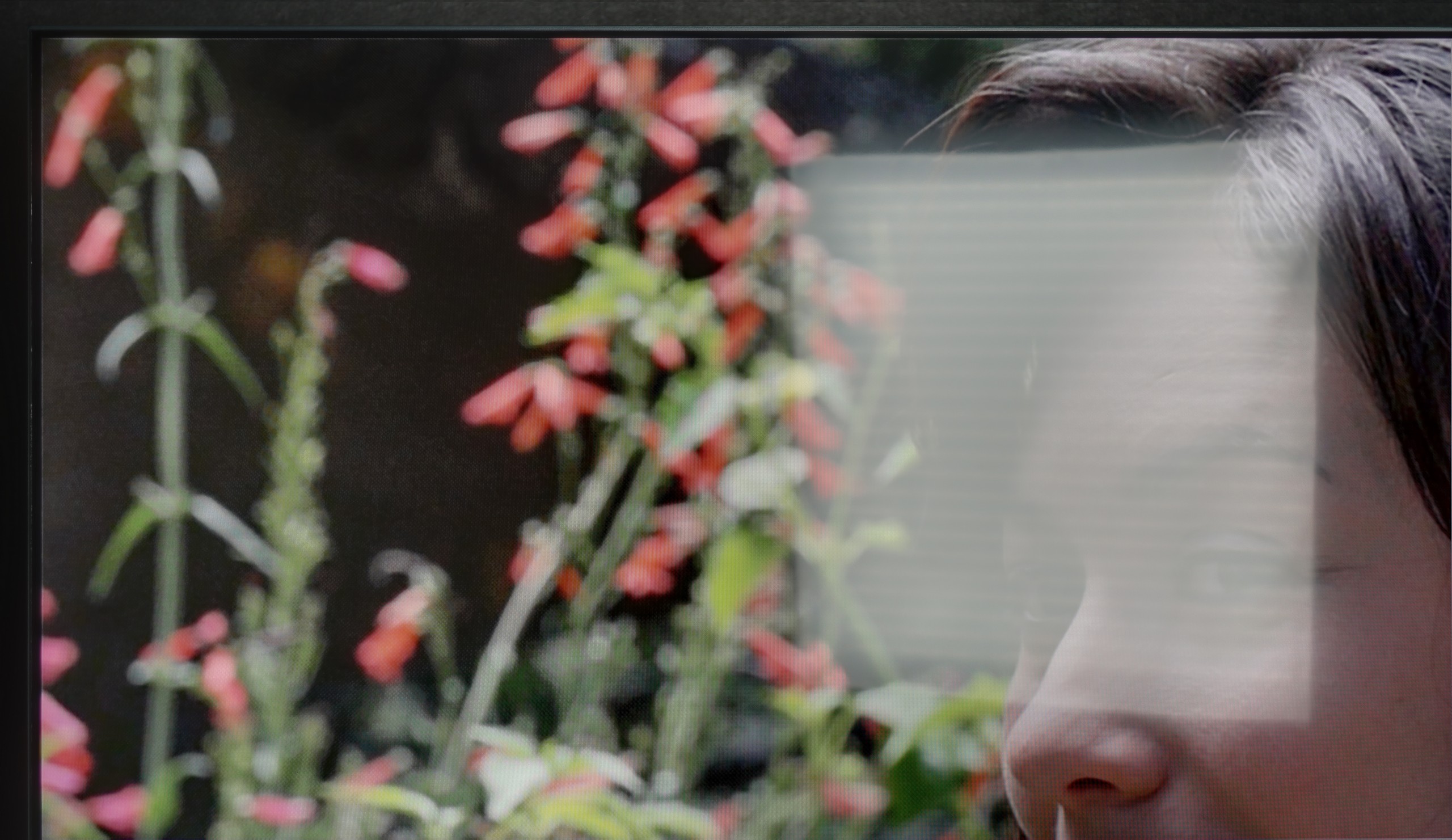
Panel finish: Satin
Reflection suppression: Decent
Black levels during daytime: Good
The Hisense E7Q / E79Q performs best in moderately bright living rooms. Its brightness ranges from 350 to 380 nits, so in typical home conditions, the picture looks good, but in very sunlit rooms, it begins to lose clarity. This is simply not a screen for interiors with large windows or strong daylight. On the plus side, it is worth mentioning the satin coating of the panel, which quite effectively suppresses reflections – both from lamps and from windows. Thanks to this, even if the room is not in dim lighting, the image still remains fairly readable.
Panel brightness
Average luminance SDR
Hisense E7Q / E79Q: 371 cd/m2
HISENSE E7Q / E79Q - TV features
8.7/10
System: VIDAA
System performance: Decent
- HDMI inputs: 3 x HDMI 2.0, 0 x HDMI 2.1
- Other inputs: Component (YPbPr)
- Outputs: Toslink (Optical audio), eARC (HDMI), ARC (HDMI), Mini-Jack (Headphones)
- Network Interfaces: Wi-Fi 2.4GHz, Wi-Fi 5GHz, Ethernet (LAN) 100Mbps
- TV reception: DVB-T, DVB-T2, DVB-S, DVB-S2, DVB-C
Classic features:
Recording to USB (terrestrial TV): Yes
Recording programming: Yes
Picture in Picture (PiP): No
RF remote control (no need to aim at the screen): RF
Backlit remote control: No
Teletext: Yes
Audio only mode: Yes
Bluetooth headphones support: Yes
Simultaneous Bluetooth headphones & TV audio: Yes
Smart features:
AirPlay: Yes
Screen mirroring (Windows Miracast): Yes
Voice search: Yes
Voice search in native language: Yes
Ability to connect a keyboard and mouse: Yes








SmartTV Features: Vidaa
When it comes to Smart TV features, the Hisense E7Q / E79Q runs on the VIDAA system, which has been developed by the Chinese manufacturer for several years. It is evident that the software is maturing – it includes AirPlay, Screen Mirroring, and voice search in many languages, including Polish. Unfortunately, in our unit, it operated quite slowly, which surprised us somewhat, as in other Hisense models this system reacted much faster. A downside is the limited application library. Of course, the most important apps are available – Netflix, Disney+, and YouTube – but it's worth checking before purchase if you will find everything you use on a daily basis there.
Classic Features
In terms of traditional television functions, the E7Q performs significantly better. It has practically everything one could expect from a classic television: recording from built-in tuners to USB, a headphone jack output, and even a component input for older audio equipment. Additionally, it offers full audio support via eARC, so you can be assured that regardless of the situation, the soundbar will always "play as it should." The remote is also fairly traditional, well-designed with a large number of buttons (including numerical ones), which may appeal to those who still watch regular television on their TV. 😉
Sound connection options
HDMI audio:
Other audio outputs:
Toslink: Yes
Stereo (Mini-Jack): Yes
Wireless audio:
Bluetooth: Yes
Supported audio formats (external HDMI eARC audio):
Dolby Digital Plus 7.1: Yes
Dolby True HD 7.1: Yes
Dolby Atmos in Dolby Digital Plus (JOC): Yes
Dolby Atmos in Dolby True HD: Yes
DTS:X in DTS-HD MA: Yes
DTS-HD Master Audio: Yes
Senior accessibility
Numeric keyboard on TV: Yes
Font size adjustment: No
Audio description: Yes
HISENSE E7Q / E79Q - Apps
7.7/10























HISENSE E7Q / E79Q - Playing files from USB
8.2/10

| Maximum photo resolution: | Supported photo formats: |
|---|---|
The media player in the Hisense E7Q / E79Q works properly, but it can be finicky. The biggest problem concerns photo support – the television only handles selected formats, and some files simply do not open. This is quite surprising, as even cheaper models from other manufacturers usually do not have this issue. Videos and music play without major problems; however, one must take into account that the E7Q is not a master of versatility when it comes to files from a pendrive. It is rather a basic player that works – as long as we don't try to 'surprise' it with something.
HISENSE E7Q / E79Q - Sound
6.3/10
83dB
Maximum volume
Supported codecs
(TV speakers)
Dolby Digital Plus 7.1
Dolby True HD 7.1
Dolby Atmos in Dolby Digital Plus (JOC)
Dolby Atmos in Dolby True HD
DTS:X in DTS-HD MA
DTS-HD Master Audio
The sound in the Hisense E7Q / E79Q is exactly as one might expect from a television in this price range – rather flat, but quite loud. During measurements, the maximum volume reached about 83 dB, so it is more than sufficient for everyday viewing. The dialogues are clearly audible, which somewhat compensates for the lack of pronounced bass and depth. There are no revelations here: it is simply a solid minimum that can be accepted. However, a plus point is the wide support for audio formats. The television handles Dolby TrueHD, Dolby Atmos, and even the increasingly rare DTS:X. That is quite a nice bonus, as at least we can be sure that regardless of the source – everything will sound as it should. (Definitely when we connect it to an external audio source such as a soundbar).
Sound Quality Test:
Acoustic Measurements
83dBC (Max)
75dBC
HISENSE E7Q / E79Q - Panel details
Subpixel Structure:
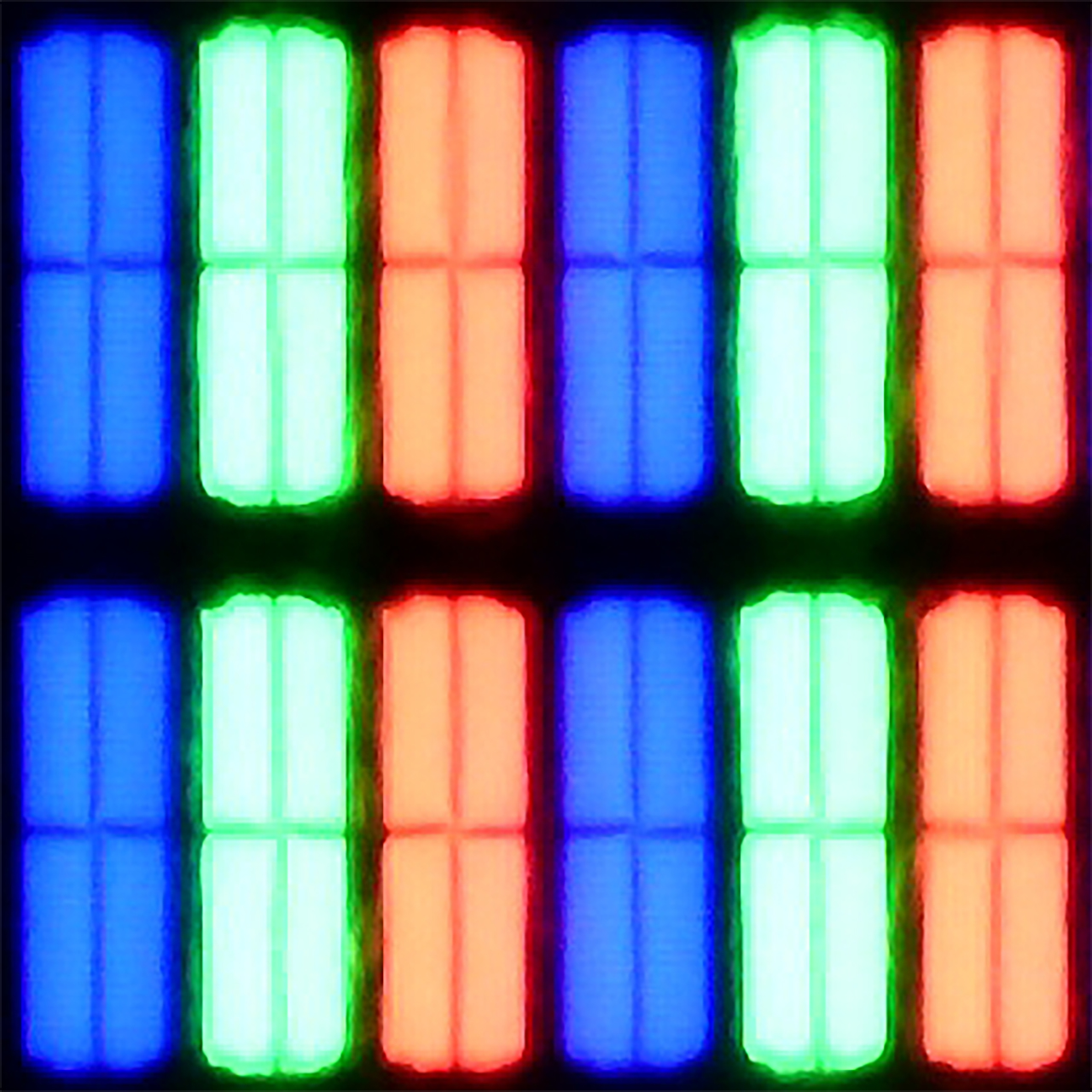
Panel uniformity and thermal imaging:
Backlight Type: PFS LED

Founder and originator of the "ChooseTV" portal

Journalist, reviewer, and columnist for the "ChooseTV" portal
See articles related to Hisense E7Q / E79Q:
9/25/2025
Shopping Reviews
Hisense televisions on sale – which models from 2024 are wor... 5/28/2025

